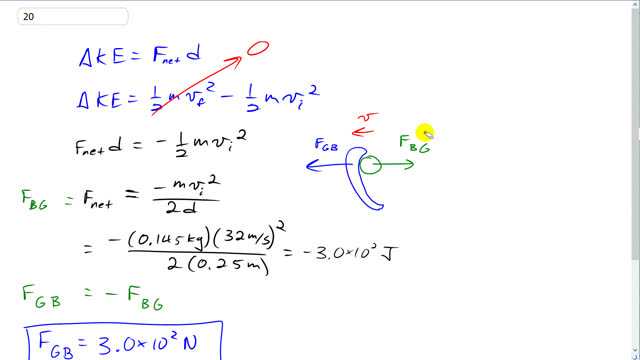
A baseball traveling 32 m/s moves a fielder’s glove backward 25 cm when the ball is caught. What was the average force exerted by the ball on the glove?

In order to watch this solution you need to have a subscription.
This is Giancoli Answers with Mr. Dychko. Since we know a whole bunch of data about the ball, we are gonna figure out the net work done on the ball and figure out the force on the ball due to the glove. And then since the force on the ball due to the glove is a Newton's third-law counterpart to the force on the glove due to the ball, they will have equal size forces but just in opposite directions. So the change in kinetic energy of the ball is the net force on it times its displacement. But there's only one force on the ball that we care about; there's also gravity down, I suppose, but that doesn't matter here because we are just considering the horizontal direction and it's moving straight horizontal, we assume. So, the force on the ball due to the glove, is the net force and that's what we say right here. Now, the change in kinetic energy is one-half m v f squared but it comes to a rest so, the final kinetic energy is 0, and so we have the net force times the displacement of the ball equals the negative one-half mass times initial velocity squared. So, the force on the ball due to the glove then is negative m v i squared over 2d, because you can divide both sides by d here and that gives us negative 0.145 times 32 meters per second squared and divide by 2, divide by 0.25 meters— displacement of the ball and glove as it comes to a stop— and that is negative 3.0 times 10 to the 2 joules. So since the force on the glove due to the ball is the negative of the force on the ball due to the glove, we have the answer to our question, the force on the glove is 3.0 times 10 to the 2 newtons, positive, because the glove is going to the left and the force on the glove is also to the left and so they are in the same direction. So the work done by that force is positive.
This answer is wrong? Its supposed to be a multiplication not a sum, right?
Hi coralis.hernandez1,
Thank you for your question. I'm not really sure how to answer it though since I need some more details about what you're asking about. What are you proposing to multiply? The solution video appears to be correct, unless I'm missing something. We determine the net force on the ball as a result of it's change in kinetic energy, and that net force turns out to be the force on the ball due to the glove. The force on the glove due to the ball is what the problem asks us for, and that is the Newton's Third Law "reaction" counterpart to the force on the ball due to the glove. Taking the "negative" (multiplying by negative one, in other words) gives the answer.
All the best,
Mr. Dychko
The force of the ball on the glove is in joules? The answer is in Newtons, though. What am I missing?
Hi fortunado09, sorry about this one. I misspoke in the video. Force is always in Newtons, of course! I'll make a note above the video for other students.